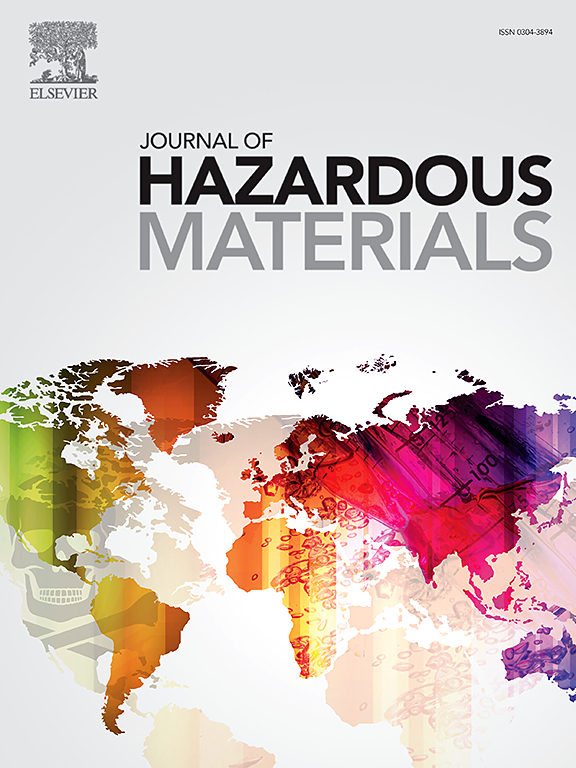Ultra-efficient degradation of isoquinoline from shale gas wastewater with the diethylamine-ferrate(VI) system: The key role of Fe(IV)/Fe(V) active species
IF 12.2
1区 环境科学与生态学
Q1 ENGINEERING, ENVIRONMENTAL
引用次数: 0
Abstract
Although isoquinoline (IQL) in shale gas wastewater contributes minimally to chemical oxygen demand, its potential high toxicity makes it an environmental risk factor that cannot be overlooked. This study introduces a synergistic diethylamine (Di)/ferrate (Fe(VI)) system for efficient degradation of IQL. Compared with Fe(VI) alone, the Di/Fe(VI) system demonstrated superior performance, achieving degradation efficiency of 80.5%. The degradation rate constant of the Di/Fe(VI) system was almost 3-fold larger than that measured with Fe(VI) alone in the degradation of IQL. Mechanistic studies, including radical quenching, electron paramagnetic resonance, pre-mixed experiments, Raman spectroscopy, and probe compounds tests suggested that high-valent iron intermediates (Fe(IV/V)) were responsible for IQL degradation in the Di/Fe(VI) system. The presence of Di promoted the generation of Fe(IV)/Fe(V) by donating electrons. Based on the intermediates identified with GC-MS measurements and density functional theory calculations, three reaction pathways for IQL degradation were proposed. ECOSAR prediction and Escherichia coli toxicity tests showed that the toxicity of IQL was significantly reduced after treatment with Di/Fe(VI) system. Optimal IQL degradation occurred at higher Fe(VI)/Di concentrations and lower pH, with minimal interference from common ions or matrix components. The system also effectively degraded pharmaceuticals (e.g., 2,4-di-tert-butylphenol, 6-methylquinoline, diclofenac, carbamazepine), demonstrating broad applicability for refractory pollutant treatment.

虽然页岩气废水中的异喹啉(IQL)对化学需氧量的影响很小,但其潜在的高毒性使其成为一个不容忽视的环境风险因素。本研究介绍了一种二乙胺(Di)/铁(Fe(VI))协同系统,用于高效降解 IQL。与单独使用 Fe(VI) 相比,Di/Fe(VI) 系统表现出更优越的性能,降解效率达到 80.5%。在降解 IQL 的过程中,Di/Fe(VI)体系的降解速率常数比单独使用 Fe(VI)测得的速率常数大近 3 倍。包括自由基淬灭、电子顺磁共振、预混合实验、拉曼光谱和探针化合物测试在内的机理研究表明,高价铁中间体(Fe(IV/V))是 Di/Fe(VI) 体系中 IQL 降解的原因。Di 的存在通过提供电子促进了 Fe(IV)/Fe(V) 的生成。根据 GC-MS 测量和密度泛函理论计算确定的中间产物,提出了 IQL 降解的三种反应途径。ECOSAR 预测和大肠杆菌毒性测试表明,经 Di/Fe(VI) 系统处理后,IQL 的毒性显著降低。最佳的 IQL 降解发生在较高的 Fe(VI)/Di 浓度和较低的 pH 值条件下,普通离子或基质成分的干扰极小。该系统还能有效降解药物(如 2,4-二叔丁基苯酚、6-甲基喹啉、双氯芬酸、卡马西平),证明了其在难降解污染物处理方面的广泛适用性。
本文章由计算机程序翻译,如有差异,请以英文原文为准。
求助全文
约1分钟内获得全文
求助全文
来源期刊

Journal of Hazardous Materials
工程技术-工程:环境
CiteScore
25.40
自引率
5.90%
发文量
3059
审稿时长
58 days
期刊介绍:
The Journal of Hazardous Materials serves as a global platform for promoting cutting-edge research in the field of Environmental Science and Engineering. Our publication features a wide range of articles, including full-length research papers, review articles, and perspectives, with the aim of enhancing our understanding of the dangers and risks associated with various materials concerning public health and the environment. It is important to note that the term "environmental contaminants" refers specifically to substances that pose hazardous effects through contamination, while excluding those that do not have such impacts on the environment or human health. Moreover, we emphasize the distinction between wastes and hazardous materials in order to provide further clarity on the scope of the journal. We have a keen interest in exploring specific compounds and microbial agents that have adverse effects on the environment.
 求助内容:
求助内容: 应助结果提醒方式:
应助结果提醒方式:


